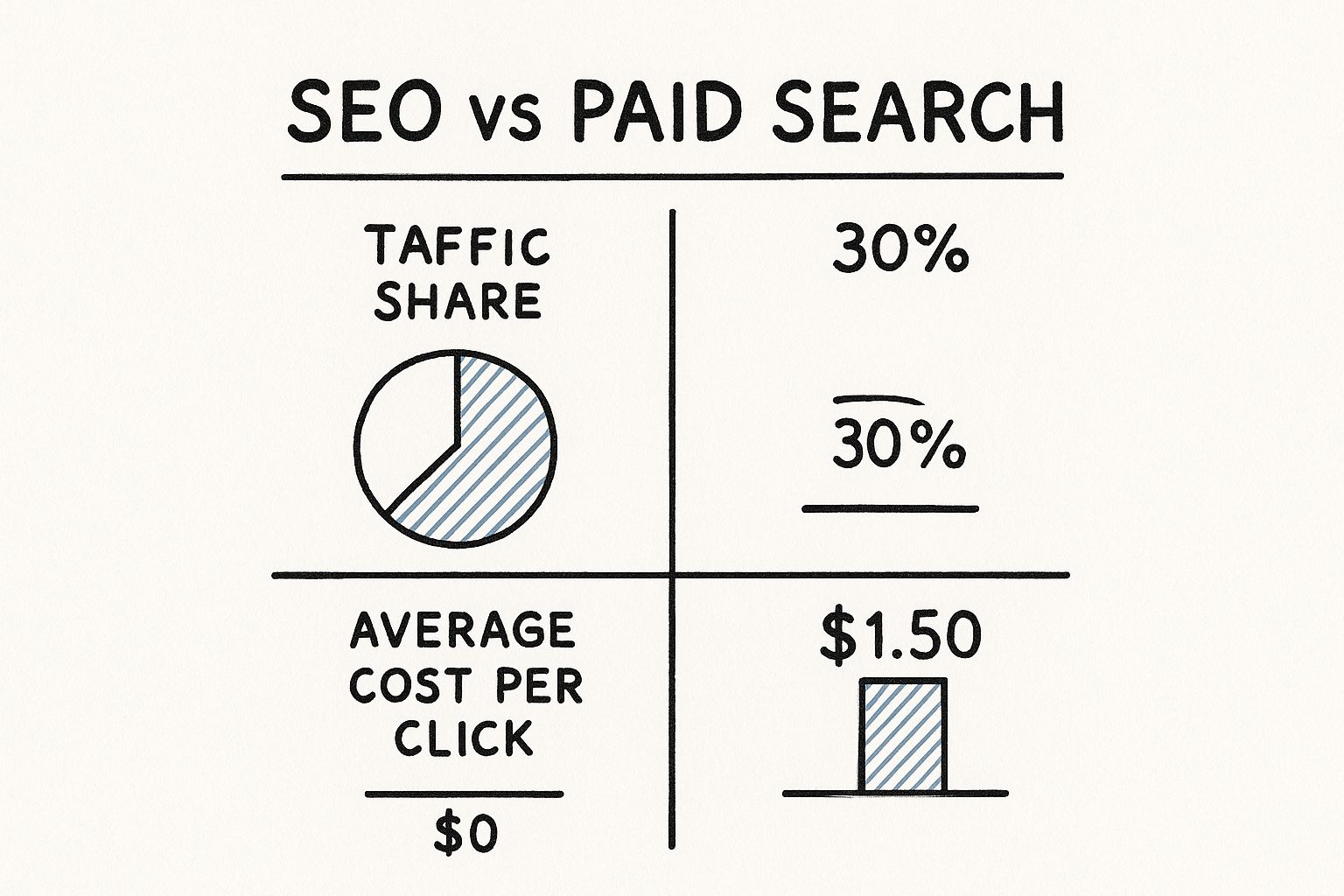Digital Marketing for Authors to Boost Book Sales

When we talk about digital marketing for authors, we're not just talking about running a few social media ads. It's about strategically using the online world to build a dedicated readership, promote your books, and carve out a professional brand that lasts. This approach shifts the focus away from old-school methods and puts you in the driver's seat, creating direct-to-reader connections through your own website, email list, and social presence. The real goal here is to build a sustainable career on the foundation of a loyal community that loves your work.
Building Your Essential Author Platform

In today's publishing world, your author platform isn't just a nice-to-have; it's the bedrock of your career. Think of it as your digital home base—the one place online where you control the entire conversation and connect directly with your audience. Don't get lost in the noise and jargon. For now, let's focus on the two pillars you absolutely must get right: a professional author website and a powerful email list.
These two assets are critical because you own them, plain and simple. Social media platforms can change their algorithms on a whim, but your website and your email list give you a direct, unfiltered line to the people who matter most: your readers.
The sheer scale of the digital marketing industry shows why this is so important for authors. With a projected global value of $472.5 billion in 2025 and an expected annual growth of 13.6%, there's no denying that digital promotion is king. And for authors, who thrive on direct communication, this is a huge opportunity. Content marketing, for instance, is a core strategy used by 76% of marketers to build brand awareness and community—a perfect match for establishing an author's unique voice.
Your Professional Author Website
Your website is your digital storefront. It needs to do more than just exist; it has to be a dynamic tool that serves both your current fans and potential new readers. A great author website doesn't need to be complicated, but it has to do a few things exceptionally well.
Here are the non-negotiables:
- A Compelling 'About' Page: This is often the first stop for visitors after your homepage. Go beyond a dry list of publications. Share your story. Why do you write in your genre? What's the passion behind the words? A professional headshot here goes a long way in making that connection feel personal.
- Dedicated Book Pages: Every book or series you've written deserves its own spotlight. Each page should feature a high-resolution cover image, a blurb that hooks the reader, and—this is crucial—clear, easy-to-find buy links for all the major retailers. You want to make it as simple as possible for someone to buy your book the second they feel that spark of interest.
- A Simple Blog: This is your space to connect with readers beyond your books. You don't need to churn out content daily. A simple monthly update on your writing process, a dive into a fascinating research topic, or a character spotlight is more than enough to keep your audience engaged and coming back for more.
The Power of Your Email List
If your website is your storefront, then your email list is your VIP room. It is, without a doubt, the most powerful marketing tool an author can have. These subscribers are your core audience—the readers who have explicitly raised their hands and said, "Yes, I want to hear from you."
An email subscriber is infinitely more valuable than a social media follower. You aren't fighting with algorithms or a crowded, chaotic feed. Your message lands directly in their inbox, creating a personal connection that social media just can't replicate.
To get started, you'll need an email service provider. Platforms like Mailchimp, ConvertKit, or MailerLite are designed to help you manage subscribers and send professional emails without any technical headaches.
Creating an Irresistible Lead Magnet
Simply sticking a "subscribe to my newsletter" box on your site won't cut it anymore. You have to offer something valuable in exchange for an email address. This is what we call a lead magnet—a free, exclusive piece of content that someone gets for joining your list.
For an author, the most effective lead magnets are tied directly to your books. Think about offering:
- A free short story set in your book's world.
- A deleted scene or an alternate ending that provides a new perspective.
- A "behind-the-scenes" guide, like a character dossier or a map of your fictional setting.
- The first few chapters of your next book.
This approach works so well because it attracts the right kind of subscriber: people who are already invested in your stories. By building these foundational elements, you create a robust platform that will support every other marketing effort you make. For a deeper look into how these pieces all fit together to drive sales, check out our comprehensive book marketing strategies guide.
2. A Realistic Approach to Social Media for Authors
Feeling completely swamped by social media? You aren't alone. The constant pressure to post on every platform can feel like a second full-time job you never signed up for. But here’s the secret: effective author marketing isn’t about being everywhere. It's about being in the right places, where you can genuinely connect with your readers.
Let's work smarter, not harder. Instead of stretching yourself thin, your real goal is to find the one or two platforms where your ideal readers actually hang out. This focused approach saves you a ton of time and energy, letting you build real relationships instead of just shouting into the digital void.
Choosing Your Core Platforms
The trick is to find a platform that clicks with both your book's genre and your own personality. A thriller author might kill it on X (formerly Twitter) with its fast-paced, news-driven conversations. Meanwhile, a Young Adult fantasy writer will likely find a much warmer home on Instagram or TikTok, which are built for visual storytelling and passionate communities.
Think about it this way:
- Are you a visual storyteller? (Romance, Fantasy, YA): Instagram is your playground. Think gorgeous cover reveals, character art, aesthetic mood boards, and short, snappy Reels that capture the feeling of your book.
- Do you love building community? (Sci-Fi, Cozy Mystery, Non-Fiction): A dedicated Facebook Group can become an incredible asset. You can host live Q&As, share exclusive behind-the-scenes tidbits, and spark conversations among fans who are already hooked on your work.
- Want to reach a new generation of readers? (YA, Romance, Contemporary): You can't ignore the power of BookTok. Short, creative videos playing on popular tropes, reacting to emotional scenes, or just sharing the vibe of your story can explode with organic reach and drive very real sales.
This image really drives home the point. It shows the fundamental difference between building an organic audience on platforms like social media and simply paying for clicks. A strong organic strategy is a long-term asset that pays dividends.

As you can see, channels like social media and SEO often drive the most traffic at a far lower direct cost than paid ads. It's an investment in your author brand.
Beyond Just Selling Your Book
This is probably the biggest mistake I see authors make: using their social media feed as a constant advertisement. Nobody wants to follow a billboard. Your social presence should be a place for connection, community, and conversation. The "buy my book" posts need to be the rare exception, not the daily rule.
The most successful authors I've seen live by the 80/20 rule. A full 80% of their content is about providing value, entertainment, or connection. Only 20% is directly promotional. This is how you build trust and keep your followers from hitting "unfollow."
So, what does that look like in practice? Instead of another "on sale now" graphic, share an interesting historical fact you unearthed during your research. Post a photo of a coffee shop that inspired a key scene. Run a fun poll asking followers to help name a side character or vote on two potential cover designs. Let them in on the journey.
Choosing the Right Platform for Your Genre
To help you narrow down your choices, I've put together a quick-reference table. Think of it as a starting point. Your unique voice and audience might lead you somewhere unexpected, but this guide can help you make a more informed decision from the get-go.
Author Social Media Platform Strategy
| Platform | Best For... | Content Ideas | Primary Audience |
|---|---|---|---|
| Visual-heavy genres (Fantasy, Romance, YA, Cookbooks) | Cover reveals, character art, Reels, author Q&As, aesthetic flatlays | Millennials, Gen Z, visually-oriented readers | |
| TikTok | High-energy genres (YA, Romance, Thrillers, Fantasy) | Short videos with trending audio, trope callouts, book reactions, "a day in the life" | Gen Z, younger Millennials |
| Building deep community (all genres, especially with older readers) | Author Groups, live video, sharing blog posts, in-depth discussions | Gen X, Baby Boomers, established fan communities | |
| X (Twitter) | Fast-paced engagement & networking (Thrillers, Sci-Fi, Non-Fiction) | Quick updates, joining industry chats (#WritingCommunity), sharing news | Journalists, industry professionals, news-savvy readers |
| Inspiration & visual discovery (Fantasy, Romance, Lifestyle, DIY Non-Fiction) | Character mood boards, setting inspiration, infographics, book-themed recipes | Primarily female audience, planners, and visual searchers |
Remember, this is about finding the path of least resistance. Go where your readers already are and where you feel most comfortable creating content. You don't need to be on all of them—just the one or two that truly fit.
Navigating the Ever-Changing Social Scene
The social media world is always in motion, which I know can feel frustrating. But staying aware of the trends is part of the game. A 2025 survey of over 850 authors found that while 78% use social media weekly, a real generational split is happening. Authors who debuted after 2020 are twice as likely to use TikTok as those published before 2010, who still lean toward platforms like YouTube.
This just proves how important it is to adapt. Be flexible. If you notice your readers are all flocking to a new platform, don't be afraid to dip your toes in and experiment. At the same time, give yourself permission to stick with what's working. If you've poured your heart into a thriving Facebook Group, you don’t need to ditch it just because a new app is trending.
Ultimately, a realistic social media strategy is one you can actually maintain without burning out. Choose your platforms wisely, prioritize connection over conversion, and give readers a reason to stick around long after your launch day. For a deeper dive, check out our complete guide to social media for authors.
Using Content and SEO to Attract New Readers

Let's talk about SEO, or Search Engine Optimization. I know, it sounds terribly technical. But for authors, it's really just about making it easier for your ideal readers to stumble upon your work when they’re searching online. Forget the complex code—this is all about connecting your stories with the people actively looking for them.
The core idea is pretty simple. Think about it: what words would someone type into Google to find a book just like yours? Your job is to sprinkle those words and phrases throughout your author website and blog. This isn't a quick fix; it's a long-term strategy for building a loyal readership that finds you organically, day in and day out.
Uncovering Your Reader Keywords
The foundation of good SEO is built on keywords, which are simply the terms people use in search engines. As an author, your most valuable keywords aren't single words but entire phrases that hint at what a reader truly wants. We call these long-tail keywords, and they are your secret weapon.
Instead of a broad term like "fantasy books," you need to get more specific. Your potential readers are searching for things like:
- "Best sci-fi books with found family"
- "Historical fiction set in Tudor England"
- "Cozy mystery with a baker protagonist"
- "Authors similar to Neil Gaiman"
These phrases are gold because they show precise intent. When you create content around these topics, you're essentially raising your hand and saying, "Hey, I have exactly what you're looking for!" You can find these gems using free tools like Google's Keyword Planner or AnswerThePublic to see what questions your audience is asking.
Creating Content That Ranks
Once you have your list of keywords, it's time to put them to work. The most effective way to do this is by maintaining a blog on your author website. Every single blog post is a fresh opportunity to show up on Google for a new search term and draw readers into your world.
For instance, if you write epic fantasy, you could publish an article titled "5 Epic Fantasy Books to Read If You Love World-Building." Then, within that list, you can naturally include your own book as a sixth suggestion. This strategy provides real value to the reader first, introducing them to your work without a hard sell.
Expert Tip: Don't just blog about your own books. Blog about the conversation happening within your genre. This establishes you as a knowledgeable and helpful voice in the community. That trust and authority will naturally lead people to check out your novels.
This approach really pays off. The digital advertising space is enormous—global spending hit around $602.25 billion by 2023, with search ads making up the biggest slice at $202.4 billion. This shows just how vital search engines are for discovery. Securing that top spot on Google can grab nearly 40% of all clicks, a number that can shoot even higher with a featured snippet. You can learn more about how these digital marketing trends impact authors at scoop.market.us.
Expanding Your Reach Beyond Your Website
Your own blog is a fantastic starting point, but it's just the beginning. To really accelerate your growth, you should explore guest posting and podcast appearances. Both strategies place you directly in front of an established audience that's already fired up about your genre.
Guest Posting This is where you write an article for another book blog or website. In exchange for your fantastic content, you get a little "author bio" at the end of the post. That bio is your prize because it includes a link back to your own website.
Here’s a quick-and-dirty guide to a successful guest post:
- Find the Right Blogs: Look for sites that cover your genre and have a genuinely engaged audience.
- Pitch a Relevant Idea: Don't just ask to write. Offer a specific article idea that fits their style and will excite their readers.
- Write an Amazing Post: Deliver high-quality, unique content that makes a killer first impression.
- Craft Your Bio: Your author bio should be a short, sweet introduction with a clear link back to your website, turning their readers into your potential visitors.
Podcast Appearances Being a guest on a book-related podcast is like guest posting on steroids. It lets a whole new audience hear your voice and get a feel for your personality, which forges a much stronger connection. Plus, most podcast hosts will link to your website in the show notes, driving traffic and giving your SEO a nice boost.
These strategies work so well because they build backlinks—links from other sites pointing to yours. In Google's eyes, these are votes of confidence. Over time, they help build your website's authority, making it easier for you to rank higher in search results.
Smart Advertising for Your Book Launch
https://www.youtube.com/embed/0R_3iarc8IA
Paid advertising can feel like a high-stakes gamble, especially for authors on a tight budget. But it doesn't have to be a money pit. When you approach it strategically, platforms like Amazon and Facebook become powerful tools for placing your book directly in front of readers who are eager to buy.
The secret? Start small, test relentlessly, and figure out what’s working before you even think about scaling up. This isn't about blindly throwing money at an ad and crossing your fingers. It's a calculated part of your overall digital marketing for authors strategy, designed to give your book that crucial boost during its most important moments—like a launch or a price promotion.
Mastering Amazon Ads
Let's face it: Amazon is the world's biggest bookstore. Its advertising platform gives you direct access to readers who are already in a "buy now" state of mind. This is your chance to catch someone at the exact moment they're searching for their next read.
You have two main ways to target readers on Amazon:
Keyword Targeting: This lets you bid on the exact search terms people are typing into the Amazon search bar. If you've written a historical mystery, you could target phrases like "Victorian era detective novels" or "mystery books set in London." You're basically meeting the reader where they are.
Product Targeting: This is a bit more direct. It allows you to place your ad on the product pages of specific books or authors. Think of it as putting a billboard for your novel right next to your biggest competitor's. If your book reads like a Tana French novel, you can have your ad show up right on her book pages.
The most important number to obsess over here is your Advertising Cost of Sale (ACoS). This percentage tells you exactly how much you're spending on ads for every dollar you earn in sales. A low ACoS means your ads are profitable. A high ACoS is a red flag telling you it's time to tweak your targeting or ad copy.
Finding New Readers with Facebook and Instagram Ads
While Amazon Ads are fantastic for capturing readers with immediate buying intent, Facebook and Instagram ads are all about discovery. These platforms excel at generating awareness and helping you find new audiences based on their interests. The targeting is so detailed that you can reach potential readers with pinpoint accuracy, even on a tiny budget.
You can build audiences based on some incredibly specific criteria:
- Interests: Target people who have liked the pages of authors in your genre (e.g., "likes Brandon Sanderson").
- Behaviors: Find users who are members of online book clubs or have shown interest in e-readers.
- Lookalike Audiences: This one is a game-changer. Facebook can take your existing email list and find new users who share similar characteristics, effectively cloning your current fanbase.
Let’s walk through a real-world scenario. Imagine you’re launching a new Young Adult fantasy novel. You could create a Facebook ad campaign targeting users aged 18-25 who have shown interest in authors like Sarah J. Maas and Leigh Bardugo. You could even narrow it down to people interested in topics like "fantasy books" and "BookTok." The ad itself could be a stunning image of your cover with a killer hook from the blurb.
This is where your creativity comes in. Run A/B tests with different images, headlines, and ad copy to see what resonates. You can start with a budget as small as $5 per day just to gather data and find a winning combination.
A Sample Ad Campaign Walkthrough
Okay, let's get practical. Imagine you're launching "The Crimson Cipher," a new urban fantasy thriller. Your initial ad budget is a modest $150 for the entire launch week. Here’s a smart way to allocate it.
| Platform | Budget | Targeting Strategy | Goal |
|---|---|---|---|
| Amazon Ads | $75 | Target keywords like "urban fantasy with female lead" and product pages of authors like Patricia Briggs and Ilona Andrews. | Capture immediate sales from active book shoppers. |
| Facebook/IG Ads | $75 | Target a Lookalike Audience based on your newsletter subscribers and users interested in urban fantasy. | Drive awareness and build pre-launch buzz. |
You’d want to launch the Amazon Ads right on release day to capitalize on sales momentum. The Facebook ads, on the other hand, could run a few days before launch, directing people to pre-order or add the book to their Goodreads "Want to Read" shelf.
Throughout the week, you'd keep a close eye on your ACoS on Amazon and your click-through rate on Facebook, ready to turn off any ad that isn't pulling its weight. This methodical approach transforms advertising from a risky expense into a measurable tool for growth. For more ideas on how to build this kind of momentum, explore our comprehensive guide on how to promote your book.
How to Nurture Your Email List and Create Superfans

Getting someone to subscribe to your email list is a huge win. But this is where the real work—and the real fun—begins. Your email list isn't just a sales tool; it's the single best place to build lasting relationships that turn casual readers into devoted superfans.
Forget the hard sell. The goal here is to make every new subscriber feel like they've just discovered something special. That experience starts the moment they sign up, with a carefully crafted automated welcome sequence.
Crafting a Winning Welcome Sequence
A welcome sequence is just a series of automated emails sent to new subscribers over a few days. It's your chance to introduce yourself, set expectations, and deliver immediate value. Think of it as a friendly onboarding process for your author brand.
Here’s a simple, effective three-email welcome sequence I've seen work wonders:
- Email 1 (Sent Immediately): Deliver the goods! This first email needs to give them the lead magnet you promised. Keep it short and sweet, thank them for joining, and give them a heads-up on what to expect next.
- Email 2 (Sent 2 Days Later): Share your story. Now's the time to connect on a personal level. Why do you write what you write? What's the passion behind your stories? End with a question to encourage a reply—something simple like, "What's your favorite book in my genre?" It’s amazing how many people will write back.
- Email 3 (Sent 4-5 Days Later): Point them to your best stuff. Now you can link to your most popular book, a fan-favorite blog post, or your social media community. This guides them deeper into your world without being pushy.
This sequence warms up your new subscribers, building trust and familiarity right from the start.
Your Simple Author Newsletter Content Plan
Once the welcome emails are done, you need a plan for your regular newsletters. The key to successful digital marketing for authors is consistency, not complexity. Aim for one or two engaging emails per month. The last thing readers want is another "buy my book" message clogging their inbox.
Your newsletter should feel like a personal letter from a friend, not a corporate announcement. The goal is connection. When you build a genuine relationship, the sales will follow naturally when you have a new book to share.
Here are some content ideas that go way beyond just selling:
- Personal Writing Updates: Share a photo of your messy desk or a quick update on your current work-in-progress. Let them feel like they're part of your creative journey.
- Exclusive Excerpts: Give your subscribers a sneak peek of an upcoming chapter or a deleted scene that didn't make the final cut. This is pure gold for your biggest fans.
- Cover Reveals: Let your email list be the very first to see your new cover. It’s a simple way to make them feel like valued insiders.
- Behind-the-Scenes Content: Did you take a research trip? Did a real-life event inspire a plot twist? Share those interesting tidbits.
- Special Promotions: Offer your list exclusive access to discounts or limited-time sales before anyone else.
The Power of Smart Segmentation
As your list grows, you can make your emails even more effective by segmenting your subscribers. Don't let the term intimidate you—it just means dividing your list into smaller groups based on their interests so you can send them more relevant content.
For example, imagine a fantasy author who also writes sci-fi. They could segment their list by genre. When their new fantasy book comes out, they can send a targeted announcement just to the fantasy readers. This boosts engagement and dramatically reduces the chance of someone unsubscribing because they got an email about a genre they don't read.
Most email providers, like Mailchimp or MailerLite, make this easy. You can create segments based on which lead magnet someone signed up for or by simply asking subscribers to self-select their favorite genres in a follow-up email. This simple tactic ensures your messages always hit the mark, solidifying your reputation as an author who truly gets their readers.
Frequently Asked Questions About Author Marketing
Even the most seasoned authors have questions when it comes to marketing. It's a different skillset than writing, after all. I get asked these questions all the time, so let's cut through the noise and get you some practical answers.
How Much Time Should I Really Spend on Marketing?
This is the million-dollar question, isn't it? The honest answer is that it ebbs and flows. You don't have to live in a constant state of marketing overwhelm. The key is to match your effort to where you are in your book's lifecycle.
Think of it less like a marathon and more like a series of focused sprints. The week your book launches will demand a lot more from you than a quiet month six months later. This approach is not only more effective, but it's also crucial for avoiding burnout.
To give you a clearer picture, here’s a sample schedule that breaks down how you might balance writing and promotion during different phases.
Marketing Time Allocation for Authors
This table is a realistic guide, not a rigid set of rules. Think of it as a framework to help you plan your weeks so you’re focusing on the right tasks at the right time.
| Phase | Recommended Marketing Hours/Week | Primary Focus |
|---|---|---|
| Pre-Launch (6-8 weeks out) | 5-10 hours | Building buzz, securing guest posts, priming your email list, creating ad visuals. |
| Launch Week | 10-15+ hours | Actively engaging on social media, running ads, sending multiple newsletters. |
| Post-Launch (First month) | 3-5 hours | Monitoring ad performance, sharing reviews, maintaining social media presence. |
| Evergreen (Between books) | 1-2 hours | Writing a monthly newsletter, drafting one blog post, light social media engagement. |
Viewing your digital marketing for authors through these phases makes it feel so much more achievable. You’re not trying to do everything at once; you’re being strategic.
When Should I Start Marketing My Book?
Way earlier than you probably think. For most authors, the sweet spot to start laying the foundation is at least three to six months before your publication date.
Now, that doesn't mean you should be spamming "buy my book!" for half a year. Absolutely not. Early-stage marketing is much more subtle and strategic.
It’s all about getting your ducks in a row:
- Build your platform: This is the time to start growing your email list with a compelling lead magnet.
- Warm up your audience: Start posting valuable, non-salesy content on your main social media channel to foster a community.
- Network with purpose: Begin reaching out to podcasters, bloggers, and fellow authors in your genre. You can schedule guest appearances and cross-promotions that will drop right around your launch week.
I always tell authors to think of it like planting a garden. You can’t just show up on launch day and expect a full harvest. You need to plant the seeds months in advance, water them consistently, and build an audience that's actually excited when you finally announce your book is ready.
How Do I Know if My Marketing Is Actually Working?
This is where so many authors get stuck. You're putting in the time, but are you getting results? The only way to know is to track the right things—and I’m not talking about vanity metrics like your follower count.
You need to focus on data that directly impacts your author career, namely, your sales and your audience growth.
You don't need a complex analytics dashboard to see what's working. Focus on a few key metrics for each channel. If you can't tie an activity back to a specific goal—like getting a new email subscriber or a book sale—it might not be worth your time.
Here are the numbers that truly move the needle:
- Email Marketing: Look at your open rate (did your subject line work?), click-through rate (are they clicking your links?), and subscriber growth. These tell the story of your audience connection.
- Website Traffic: A free tool like Google Analytics is perfect. Check which pages and blog posts get the most visitors. This is a goldmine for understanding what content resonates with your readers.
- Paid Ads: This is all about the money. For Amazon Ads, your key metric is Advertising Cost of Sale (ACoS). For Facebook Ads, it's your Return on Ad Spend (ROAS). Are you making more money than you're spending? If not, it's time to adjust or stop the ad.
By keeping an eye on these concrete figures, you can stop guessing. When a blog post drives a surge in newsletter sign-ups, you know to write more on that topic. When an ad campaign is losing money, you turn it off. This is how you make smart, data-informed decisions instead of just throwing spaghetti at the wall.
Ready to stop guessing and start building a real marketing plan for your book? At ManuscriptReport.com, we transform your manuscript into a complete, ready-to-use marketing kit in minutes. Get everything from blurbs and keywords to social media posts and ad copy, all designed to help you sell more books and save precious time. Stop wrestling with promotion and get your comprehensive author marketing report.
Related Articles

6 Essential Book Marketing Strategies for Romance Novels
Discover 6 proven strategies to market your romance novel effectively and boost sales.

7 Budget-Friendly Book Marketing Strategies: Complete Guide for Indie Authors
Master budget book marketing with 7 proven strategies that work on $0-$500 budgets. Real ROI data, free tools, and actionable tactics for indie authors.

Book Marketing for Self-Published Authors Demystified
Discover powerful book marketing for self-published authors. This guide offers actionable strategies to find your readers, build a platform, and boost sales.